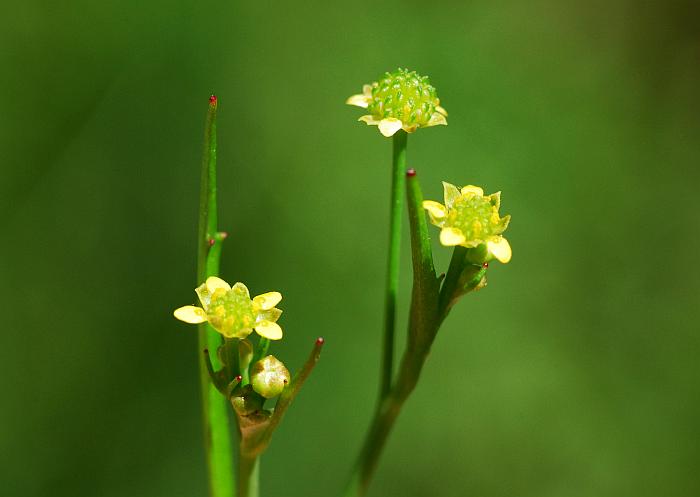Ranunculus pusillus Poir.
Low Spearwort

Native
CC = 6
CW = -5
MOC = 19
© SRTurner
Ranunculus pusillus Poir.Low Spearwort | |
 |
Native CC = 6 CW = -5 MOC = 19 |
© SRTurner |
|
Family - Ranunculaceae Habit - Annual forb with fibrous roots. Stem - Ascending to erect, or often weak and reclining in aquatic habitats, to 50 cm, often rooting at lower nodes, glabrous, without bulbils, the base not bulbous.
Leaves - Basal and alternate, glabrous. Basal leaves usually absent at flowering, when present long-petiolate, the blade 1.0-4.5 cm long, 0.5-1.2 cm wide, ovate to lanceolate, simple, the base angled or tapered, occasionally truncate, rounded or more commonly angled or tapered to a bluntly or sharply pointed tip, the margins entire or shallowly toothed, the teeth bluntly or sharply pointed at their tips. Stem leaves progressively shorter and narrower from the stem base to tip, all but the lowermost sessile, the blade simple, linear to narrowly lanceolate, the margins entire or few-toothed toward the tip.
Inflorescence - Small panicles at branch tips.
Flowers - Sepals 4 or 5, 1.5-3.0 mm long, spreading or reflexed from the base, lacking a transverse fold, more or less flat. Petals 1-5, 1.5-2.0 mm long, 0.5-1.0 mm wide, obovate to oblong, about as long as to somewhat shorter than the sepals, yellow. Style present, but short and often shed after flowering.
Fruits - Head of achenes 2-8 mm long at maturity, hemispheric to ovoid or rarely cylindric, the receptacle glabrous. Achenes 1.0-1.2 mm long, the dorsal margin bluntly to sharply keeled and sometimes very narrowly winged, the wall thick, with at least a few minute tubercles or sometimes appearing somewhat pebbled, glabrous, the beak not apparent or minute (to 0.1 mm) and somewhat peglike, usually bent to the side. Flowering - April - June. Habitat - Bottomland forests, swamps, sloughs, marshes, fens, ditches. Origin - Native to the U.S. Lookalikes - Ranunculus laxicaulis. Other info. - This little species is not often seen. It is uncommon to begin with, often largely submerged in water, and has flowers with the smallest petals of any Ranunculus. In Missouri it occurs in widely scattered locations in the southern third of the state. Its continental U.S. distribution is largely southeastern, although a far disjunct population is found in northern California. In addition to the tiny yellow flowers, the plant is characterized by leaves which are simple and undivided with long petioles. Its appearance is similar to Ranunculus laxicaulis but has even smaller flowers, which are generally similar in size to the sepals. Photographs taken at Otter Slough Conservation Area, Stoddard County, MO, 4-22-2019 (SRTurner). |